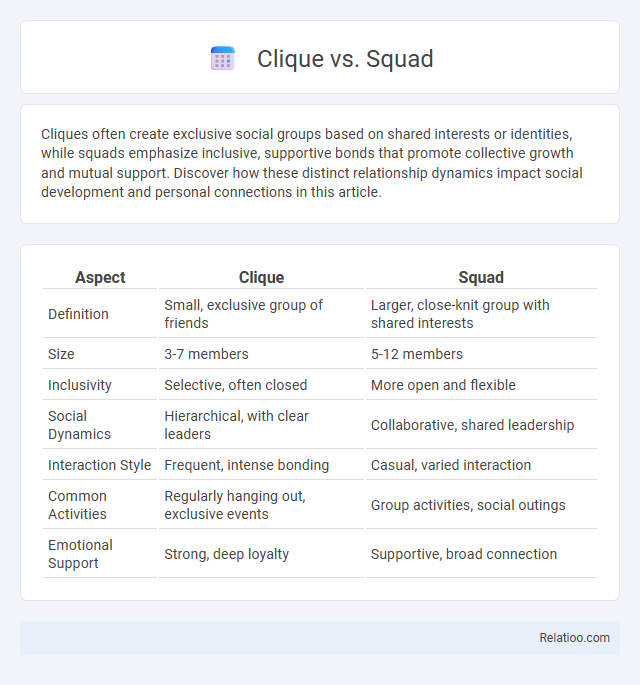Cliques often create exclusive social groups based on shared interests or identities, while squads emphasize inclusive, supportive bonds that promote collective growth and mutual support. Discover how these distinct relationship dynamics impact social development and personal connections in this article.
Table of Comparison
| Aspect | Clique | Squad |
|---|---|---|
| Definition | Small, exclusive group of friends | Larger, close-knit group with shared interests |
| Size | 3-7 members | 5-12 members |
| Inclusivity | Selective, often closed | More open and flexible |
| Social Dynamics | Hierarchical, with clear leaders | Collaborative, shared leadership |
| Interaction Style | Frequent, intense bonding | Casual, varied interaction |
| Common Activities | Regularly hanging out, exclusive events | Group activities, social outings |
| Emotional Support | Strong, deep loyalty | Supportive, broad connection |
Introduction to Clique vs Squad
Clique and Squad represent distinct social group dynamics with unique characteristics in terms of size, exclusivity, and purpose. Cliques are typically small, close-knit groups defined by strong personal bonds and often exhibit exclusivity, whereas squads tend to be larger, more inclusive networks organized around shared activities or goals. Understanding the differences between clique and squad helps in analyzing social behavior, group identity, and interpersonal relationships in various environments.
Defining Cliques: Characteristics and Dynamics
Cliques are small, tightly knit groups characterized by strong interpersonal bonds and exclusivity, often formed around shared interests or identities. Their dynamics involve clear social hierarchies and norms that regulate group membership and interactions, fostering a sense of identity and belonging. Unlike squads or broader groups, cliques emphasize exclusivity and internal cohesion, which can lead to social exclusion and reinforcement of group-specific behaviors.
Understanding Squads: Traits and Values
Squads are dynamic teams characterized by trust, collaboration, and shared goals, distinctly different from cliques that often emphasize exclusivity. Your squad fosters open communication, mutual support, and accountability, creating an environment where members thrive collectively. Understanding these traits helps you build stronger connections and achieve common objectives efficiently.
History and Evolution of Social Groups
Cliques originated as small, exclusive groups often formed during adolescence to foster identity and belonging, evolving from informal social circles into influential societal units. Squads emerged more recently as dynamic, purpose-driven collectives, blending social support with shared activities, reflecting modern emphasis on collaboration and inclusivity. Understanding the history and evolution of these social groups helps you navigate and engage with diverse community structures effectively.
Key Differences Between Cliques and Squads
Cliques are small, exclusive groups defined by close, often rigid social boundaries, focusing on shared interests or social status, while squads emphasize teamwork, mutual support, and collaborative goals within more flexible, inclusive dynamics. Cliques tend to create social hierarchies and can isolate others, whereas squads foster collective identity and encourage active participation from all members. Understanding these distinctions highlights how cliques prioritize exclusivity and social standing, contrasting with squads' emphasis on cooperation and group cohesion.
Social Effects: Inclusion and Exclusion
Cliques often create strong social boundaries, leading to exclusion of individuals who don't fit their norms, which can impact Your sense of belonging and self-esteem. Squads tend to be more flexible, fostering inclusion by accepting diverse members while still maintaining a close-knit group dynamic. Understanding these social effects is crucial for navigating peer interactions and promoting a positive social environment.
Psychological Impact on Members
Clique members often experience intense pressure to conform, which can elevate stress and anxiety levels, impacting your mental well-being. Squad dynamics tend to foster a stronger sense of belonging and mutual support, promoting positive psychological outcomes such as increased self-esteem and reduced loneliness. Compared to cliques, squads encourage open communication and collaboration, minimizing feelings of exclusion and social isolation among members.
Pop Culture: Cliques and Squads in Media
Pop culture frequently portrays cliques as exclusive social groups defined by shared interests or status, often highlighting stereotypes such as the "mean girls" or "jocks." Squads are depicted as close-knit circles emphasizing friendship and loyalty, popularized by television shows like "Gossip Girl" and Beyonce's "Single Ladies" music video. Media narratives explore these dynamics, showing how cliques create social hierarchies while squads emphasize collective identity and support.
Choosing the Right Group for You
Choosing the right group between Clique, Squad, and Clique depends on your social goals and personality fit. Cliques often have strict membership and shared interests, offering a sense of exclusivity and identity, while squads tend to be more flexible, emphasizing support and shared activities. Assessing your need for belonging, openness to diverse interactions, and the level of commitment you can provide helps determine which group aligns best with your lifestyle.
Conclusion: Embracing Healthy Social Circles
Healthy social circles, whether in a clique, a squad, or a smaller group dynamic, play a crucial role in your emotional well-being and personal growth. Understanding the differences in group dynamics helps you recognize which environment nurtures mutual respect, support, and positive influence. Embracing social circles that encourage inclusivity and authenticity fosters stronger connections and long-term happiness.

Infographic: Clique vs Squad
 relatioo.com
relatioo.com